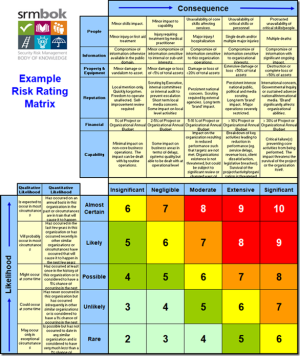Originally posted on October 1, 2012 @ 8:56 AM
Cleopatra’s Nose, Circumstance and Predictability
Rob’s book “For the Love of Zero: Human fallibility and Risk” is now available for free download. You should read the whole series of articles by Rob: CLICK HERE. I highly recommend you check out Rob’s first top seller “RISK MAKES SENSE”
 Pascal comments in Pensées that: ‘Cleopatra’s nose, had it been shorter, the whole face of the world would have been changed’. What he meant was that had Cleopatra not had a dominating nose (considered attractive and powerful at the time) then history would have evolved differently. Coins minted by Mark Antony show that Cleopatra was far from the Hollywood portrayal of her by Elizabeth Taylor. She has a pointed chin and rather large nose.
Pascal comments in Pensées that: ‘Cleopatra’s nose, had it been shorter, the whole face of the world would have been changed’. What he meant was that had Cleopatra not had a dominating nose (considered attractive and powerful at the time) then history would have evolved differently. Coins minted by Mark Antony show that Cleopatra was far from the Hollywood portrayal of her by Elizabeth Taylor. She has a pointed chin and rather large nose.
Young Cleopatra was, only twenty-one when, in 48 BC, she is said to have seduced (delivered nude wrapped in a carpet) Caesar, who was more than thirty years older and was to stay with her in Egypt until the next year, when she gave birth to Caesarion. At this point, Caesar abandoned his plans to annex Egypt, instead backing Cleopatra’s claim to the throne. After Caesar, Cleopatra seduced Mark Antony, who wanted her support against the Parthians and bore three children to him. With Antony’s power and help she had him kill all threats to her power including her sister Arsinoe. The rest, including her suicide by an Egyptian Cobra, is history.
What has the story of Cleopatra have to do with risk and safety? I will get to that shortly. First let me introduce my love of history. The study of history and historiography is a wonderful place to learn critical thinking. My first subject at University was History and my first lecturer was Dean Ashenden, later to be come well known as the originator of the Good Universities Guide. Dean opened up the world of history to all his students, challenging thinking and using critical theory to interrogate evidence. Three of my degrees have majors in history, one area of interest is Church History, what a fascinating study of humanity that is. During my early career I taught History in schools for more than 10 years. History is not about dates or civics but is the subject that teaches people how to think. If you found history boring then the teacher maybe had no idea but you weren’t doing history. History is about people and social reality, it is about how social psychology influences human judgment and decision making.
Students of history know the reality of circumstance, unpredictability and uncertainty as the phenomena of ‘Cleopatra’s nose’. It is amazing how such little things can influence the course of history, the size of a nose or the personality of a leader. Had Gough Whitlam not decided to sulk over a meat pie following his dismissal, Australia would be a different place. Had some fundamentalists not flown planes into the twin towers, the world would be a different place. Who could have predicted the USA would have a black president? This is the stuff of history. This is why they likened the election of John Howard to the second longest rule as Prime Minister in Australian History as like, ‘Lazarus with a triple by-pass’. In 1995 no-one predicted the election of John Howard as Prime Minister was possible, what is now historically referred to as ‘The Howard Years’. But history has a strange way of proving that circumstance and the improbable are indeed possible. Like many witnessed at the end of this football season, a game can be won on the odd bounce of an oval shaped ball.
The idea of predictability and certainty has a strong appeal to those with a fundamentalist mindset. There is nothing more appealing to the fundamentalist than promises to have ‘everything in control’. There is nothing so cozy as having the solution to every threat ‘in hand’, to have ‘black and white’ answers. This mathematical-like thinking is what Hudson referred to as being ‘calculative’.
We see the calculative mindset in the preoccupation of counting LTIs and frequency rates as if such have some connection to safety culture. How bizarre, like measuring effective parenting by the number of smacks administered to children. How on earth do numbers of incidents demonstrate safety culture? The idea of measuring LTIs as a predictor of safety culture is a delusion of the calculative mindset. BP Deepwater Horizon One claimed to have millions of LTI free hours before it killed 11 people and poured billions of tonnes of oil into the Mexico Gulf. The rig owner, Transocean, was said to have had a strong safety record with no major incidents for 7 years. The reality was that a culture of denial and related circumstances blinded leaders to ‘warning signs’ that generated the explosion.
The calculative mindset understands safety and the management of risk as a ‘science’. Indeed, the idea of ‘safety engineering’ and ‘safety science’ seems to appeal to some people as if humans are machine-like in what they do. Such calculative thinking appeals to the lovers of Behavioural Based Safety, as if humans are the sum of inputs and outputs. What a shame for them that history shows this is not the case.
The fundamentalist mindset thinks crazy words such as ‘all accidents are preventable’ are somehow motivational and attractive. Such thinking and words are a denial of the evidence of history. Absolutist and perfectionist language should have no place in the world of risk and safety. Such language can only lead to delusional anti-human thinking that denies that the shape of a girl’s nose can change the course of human history.



Do you have any thoughts? Please share them below